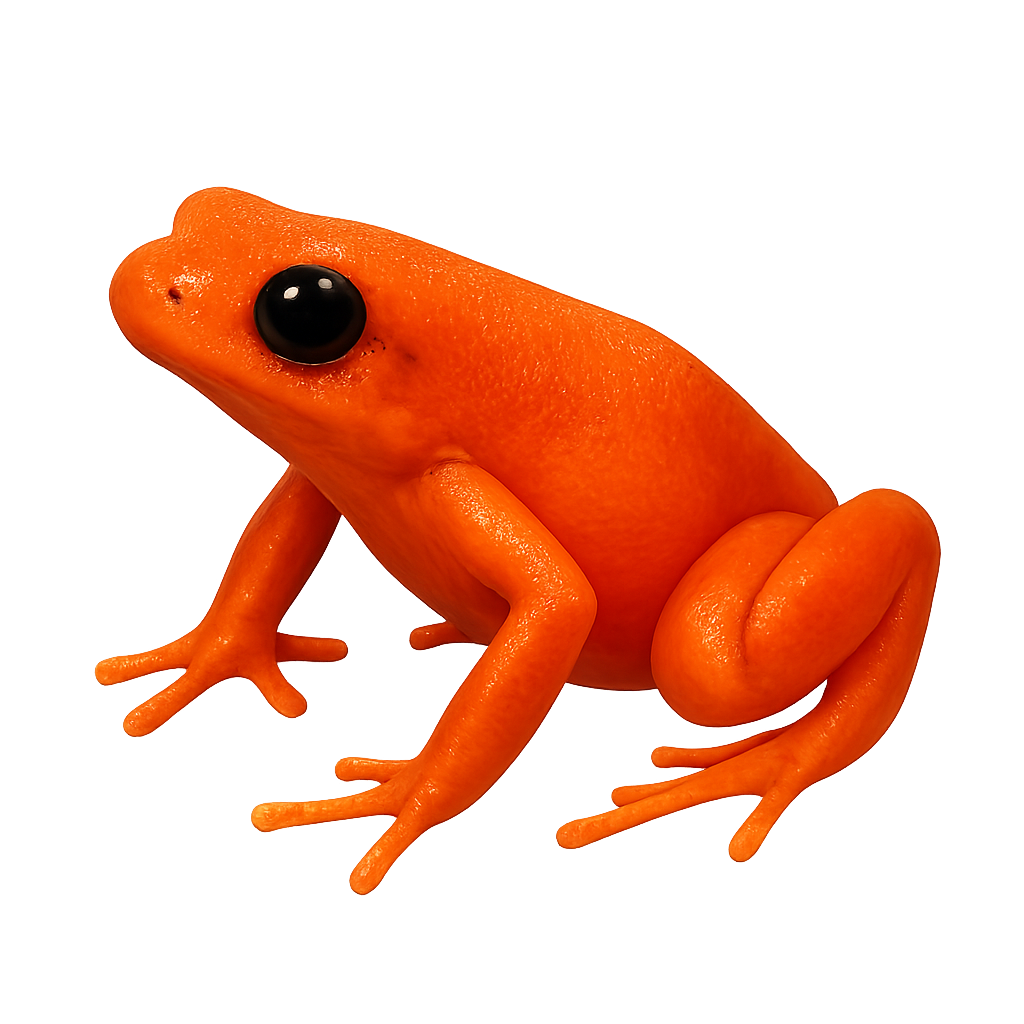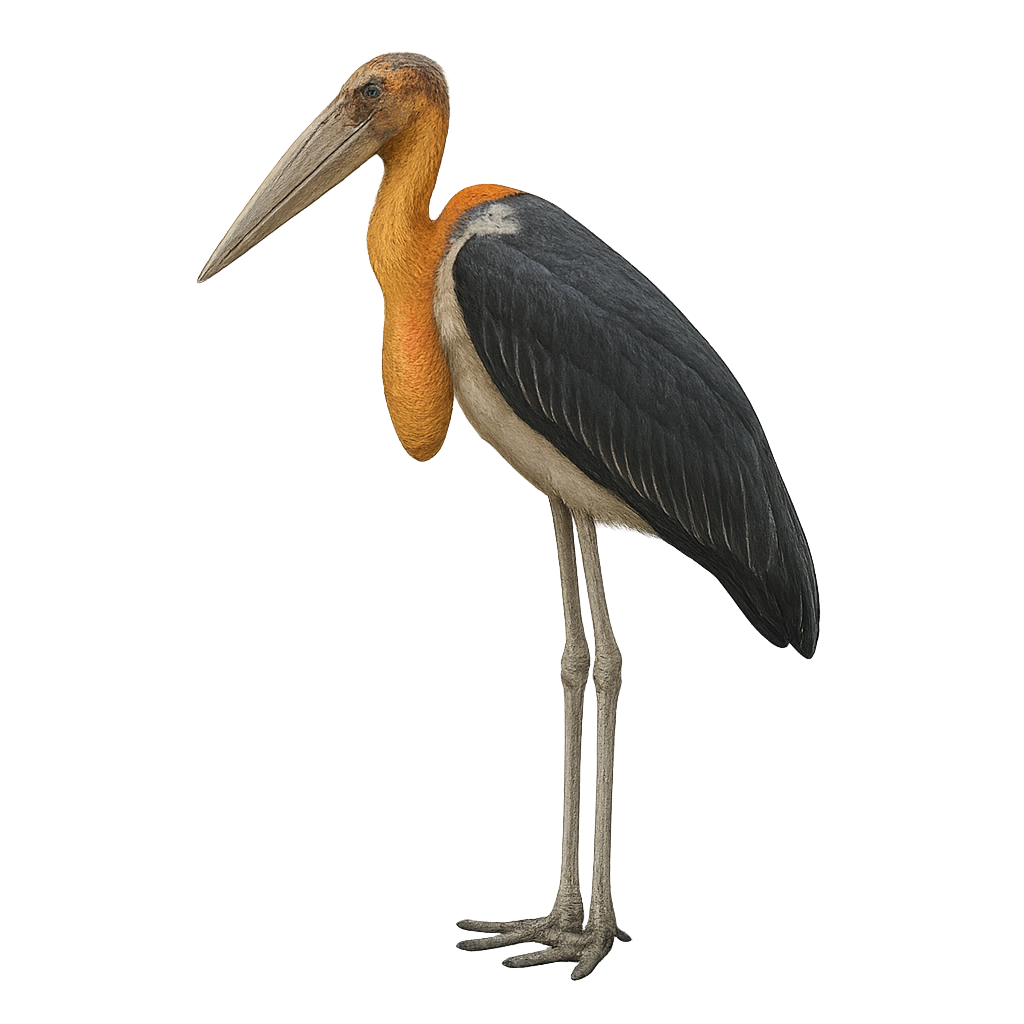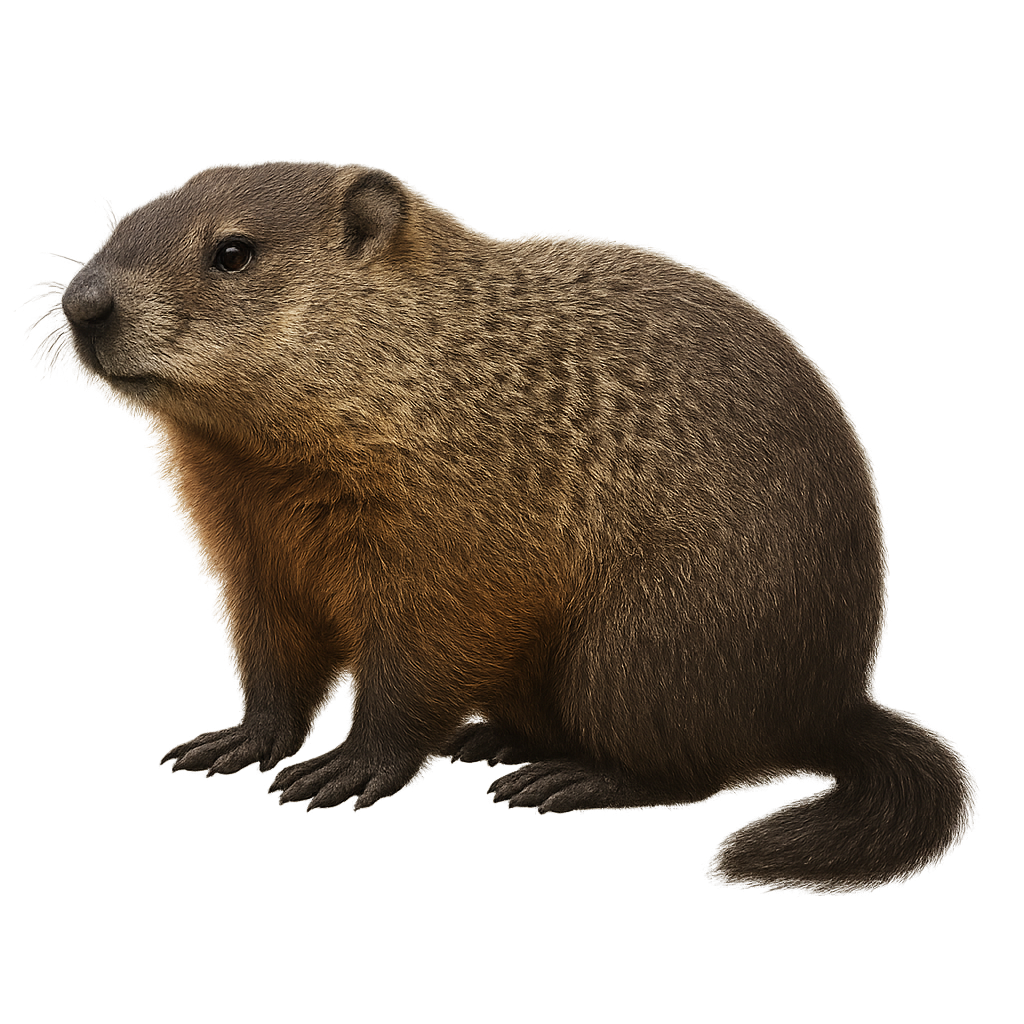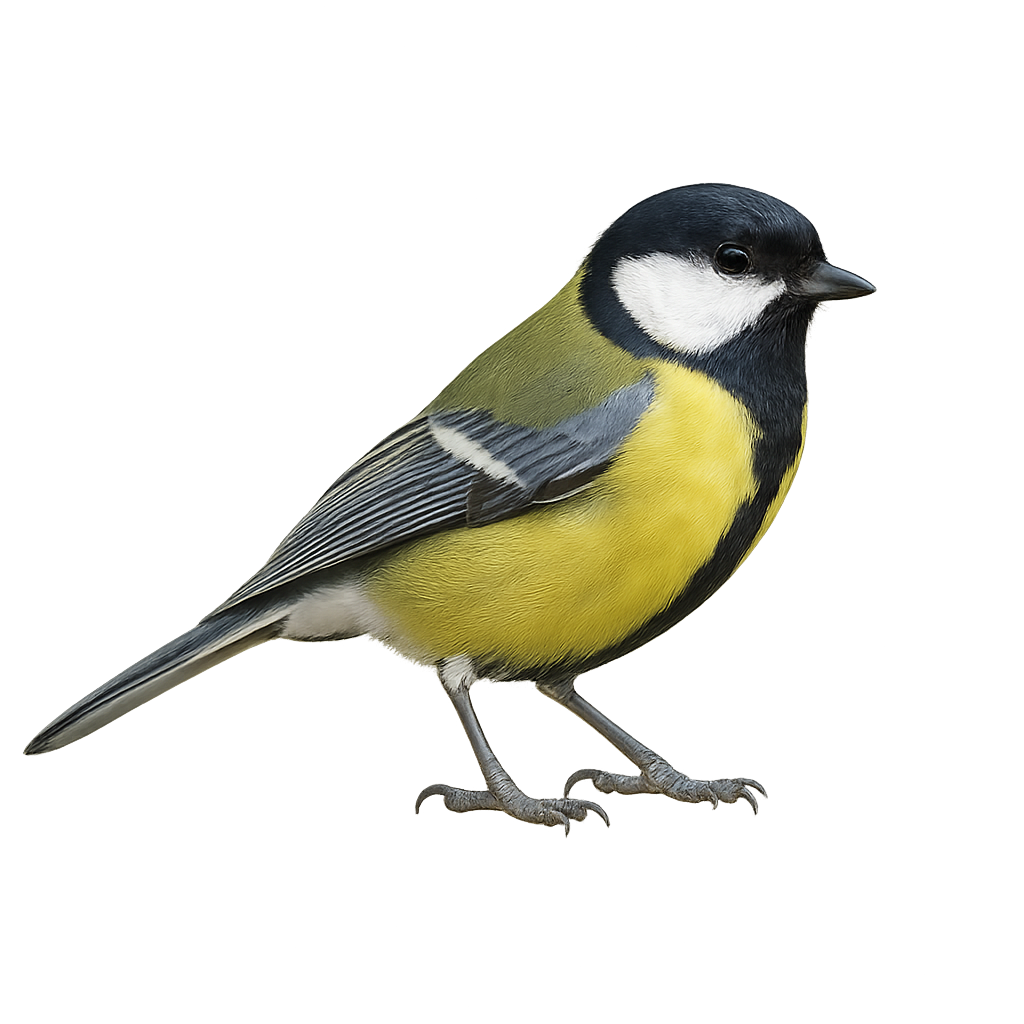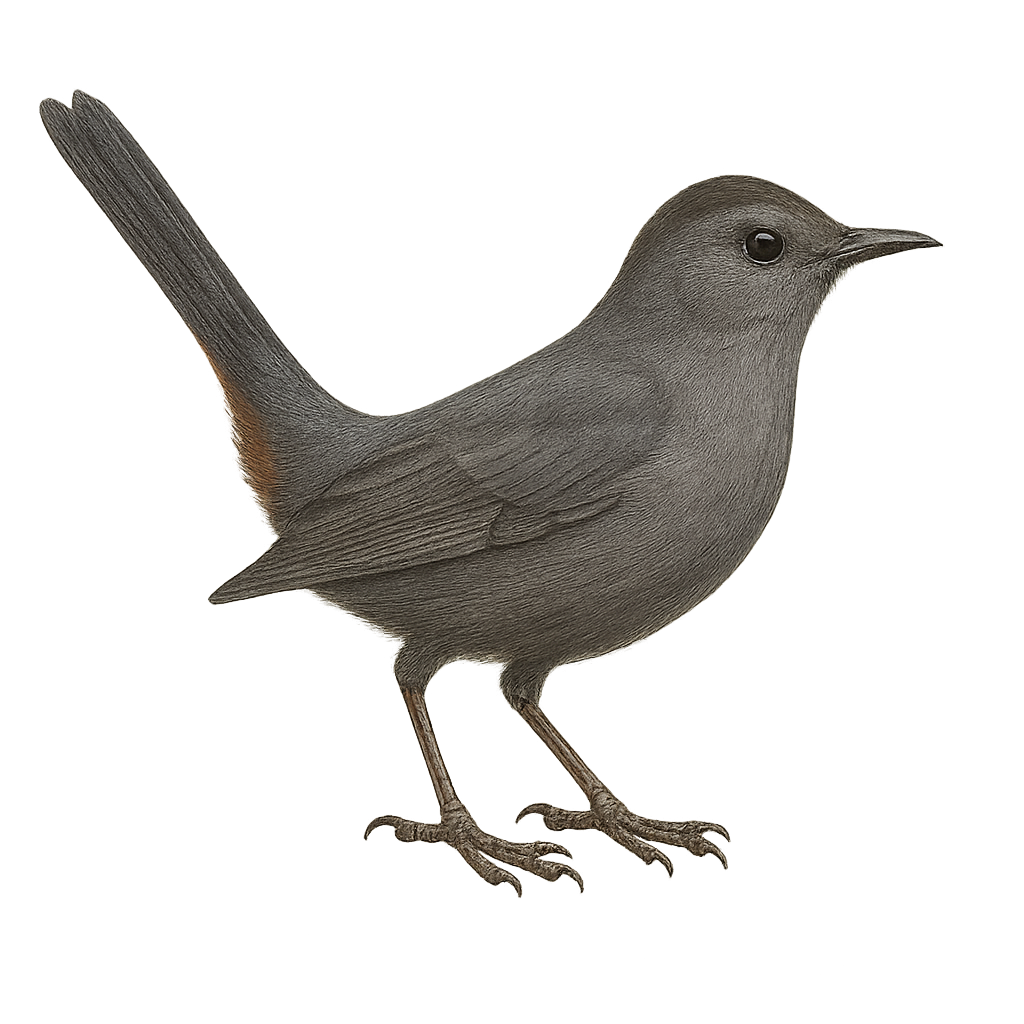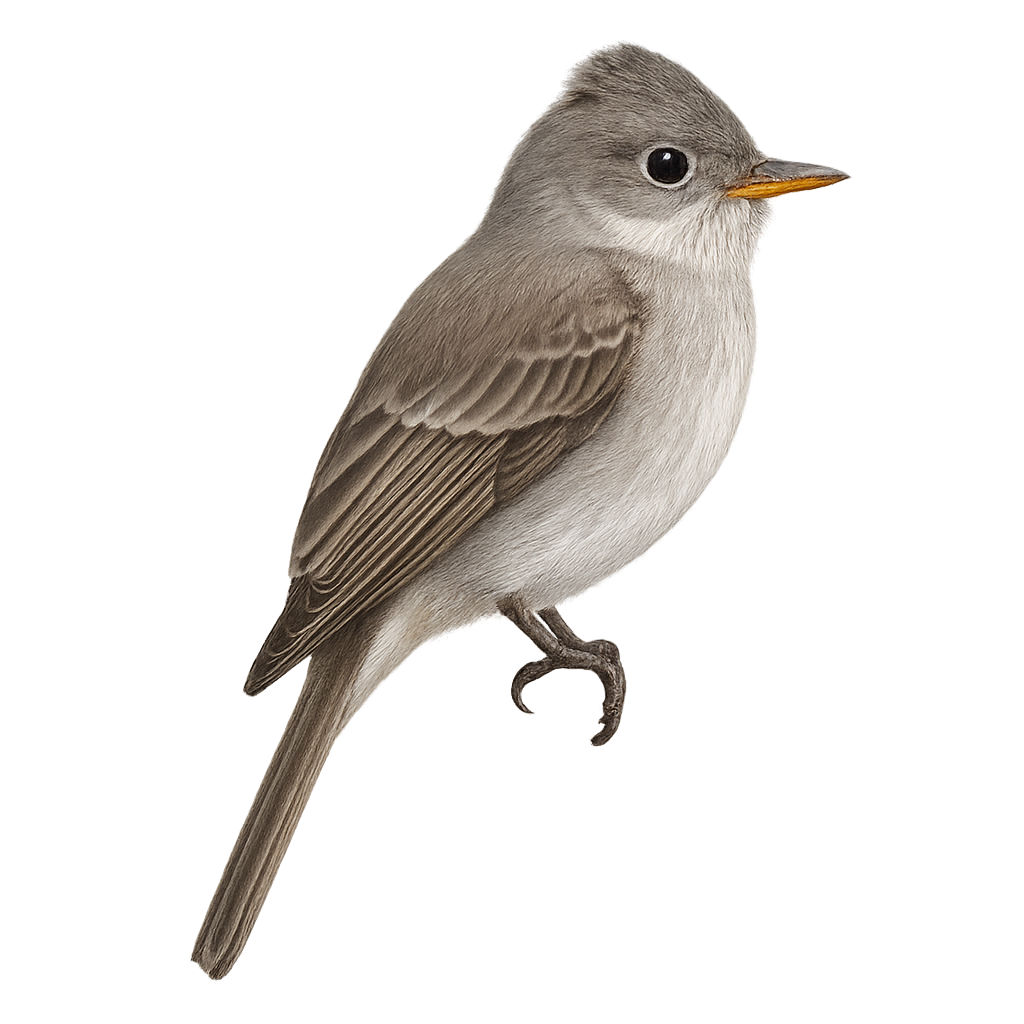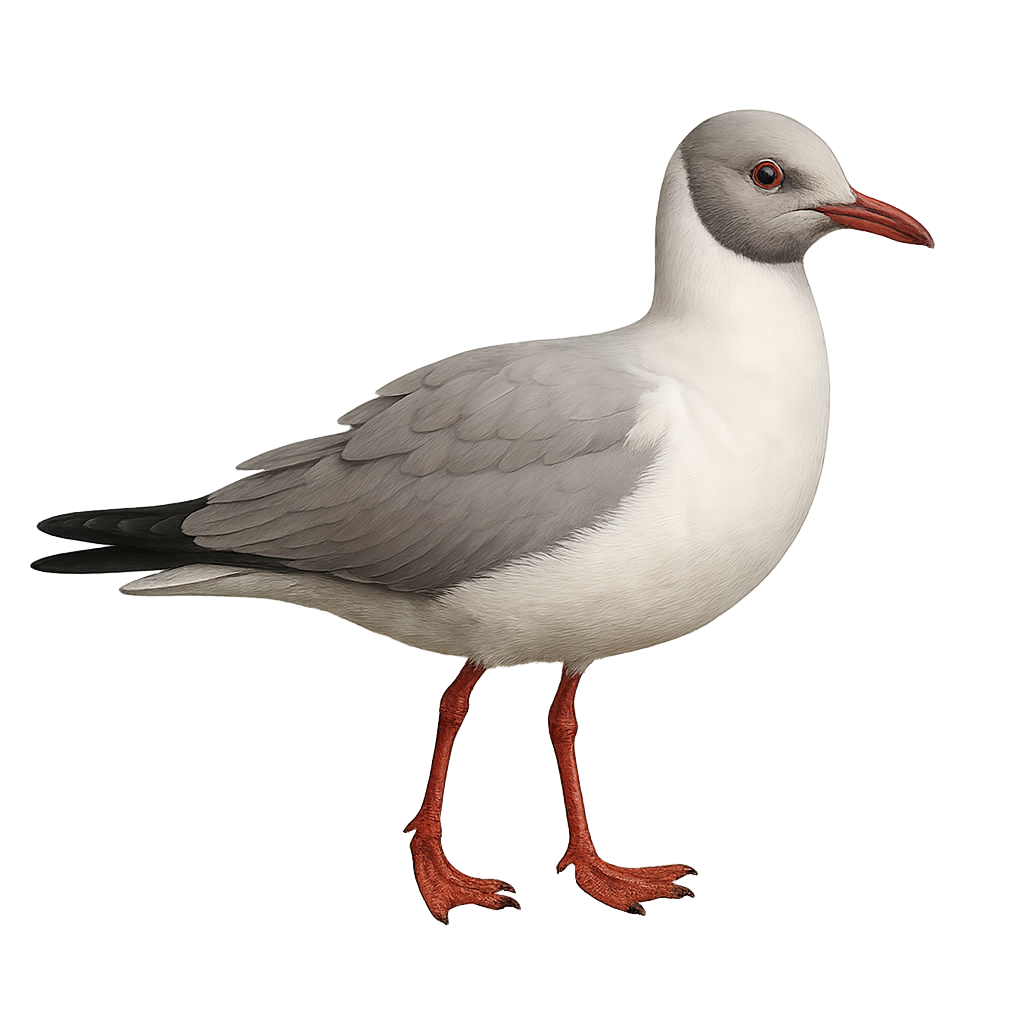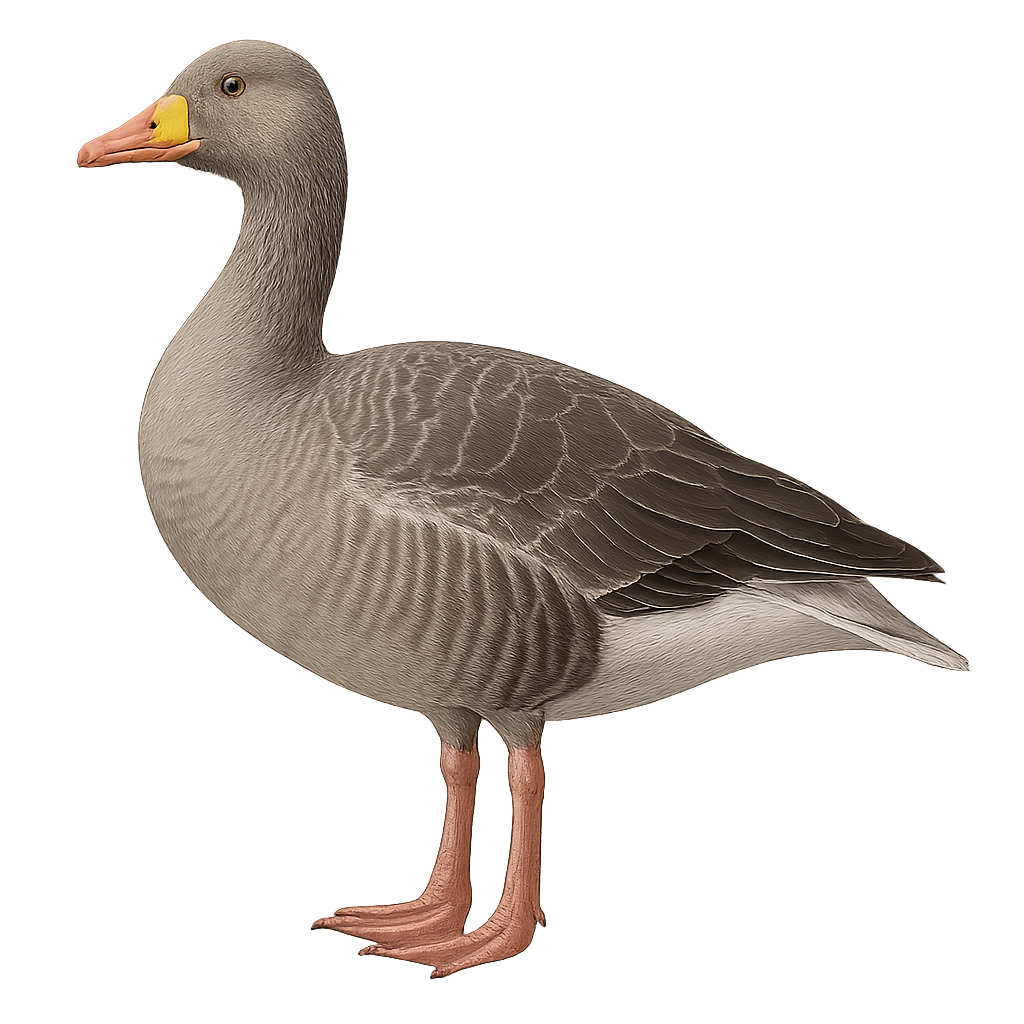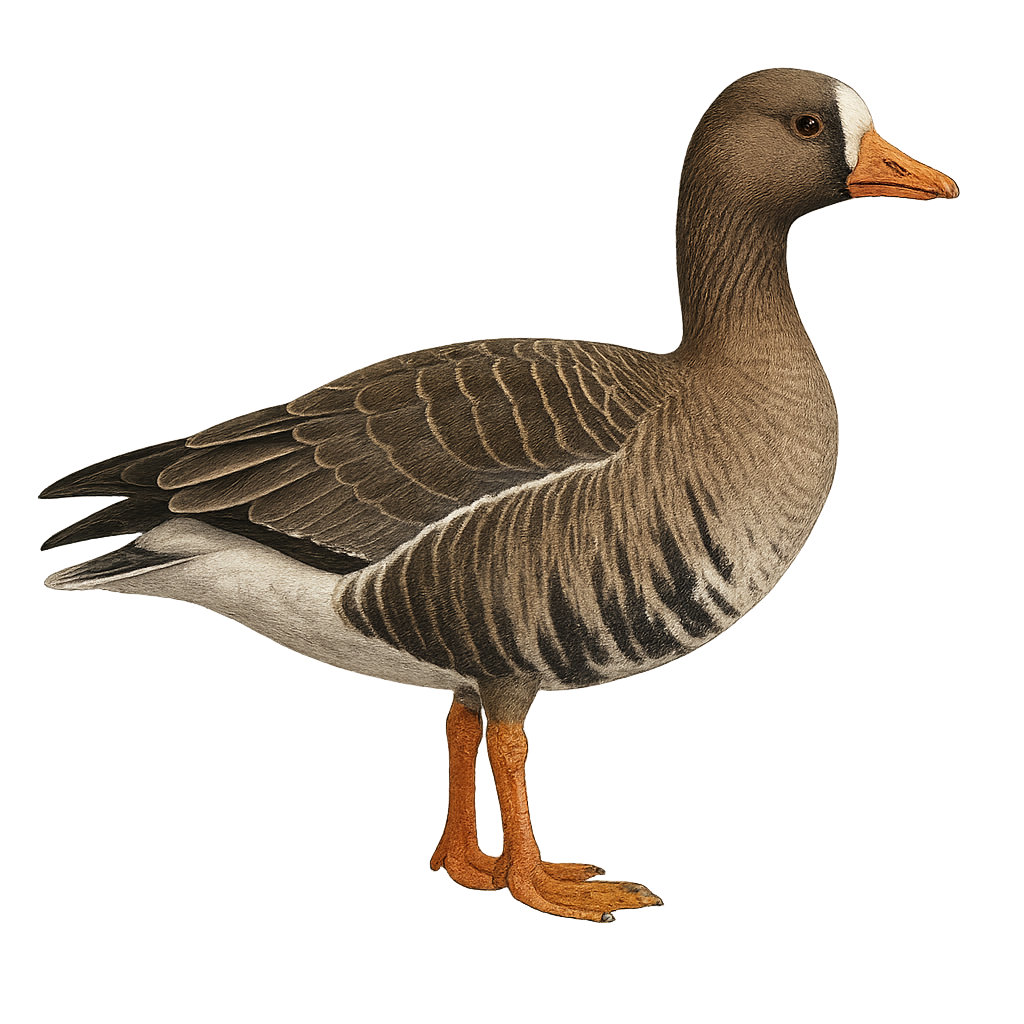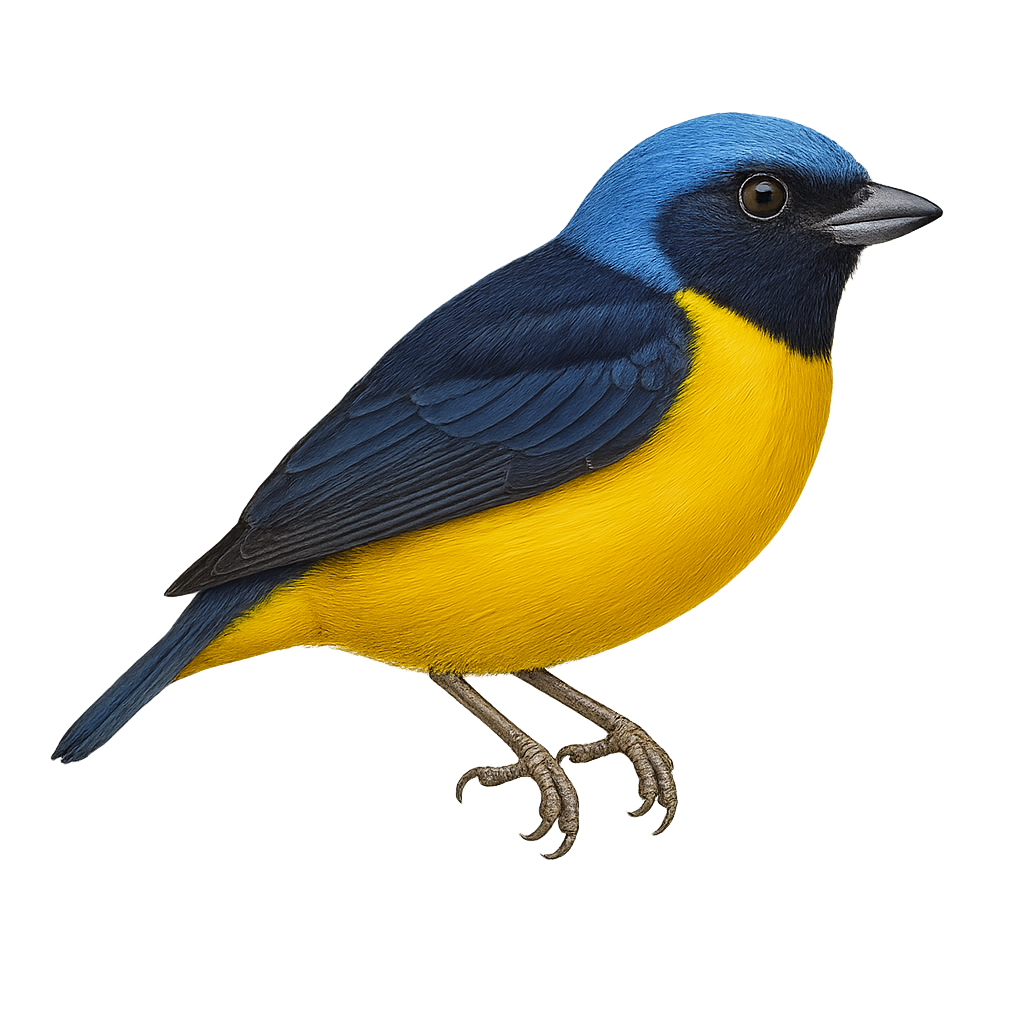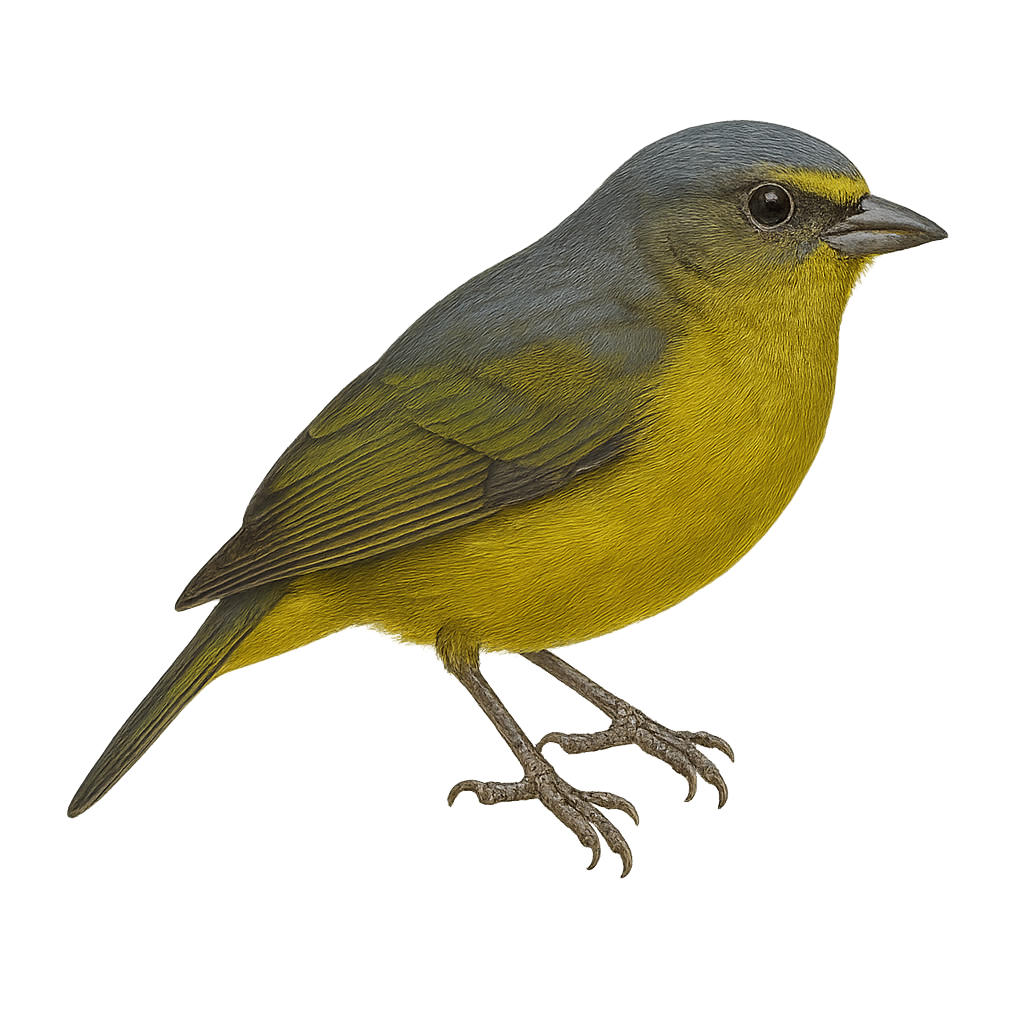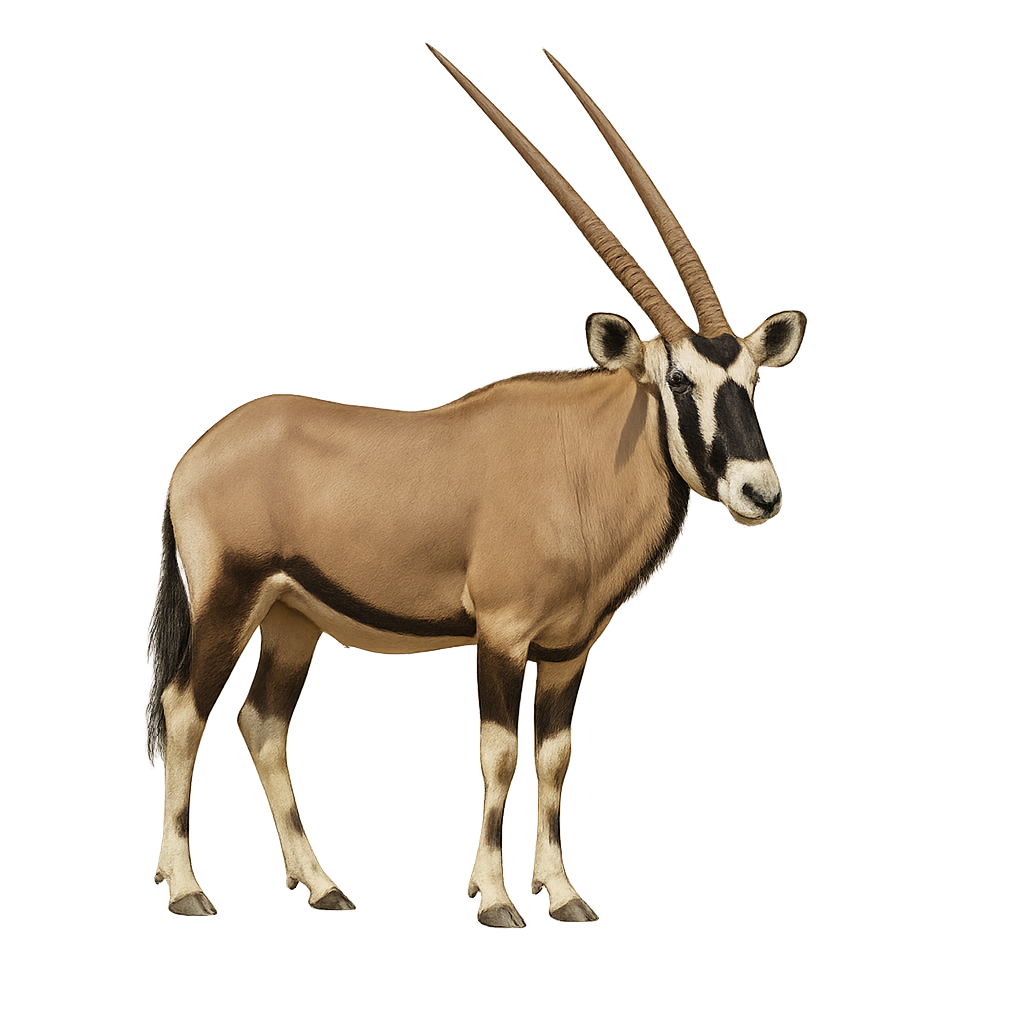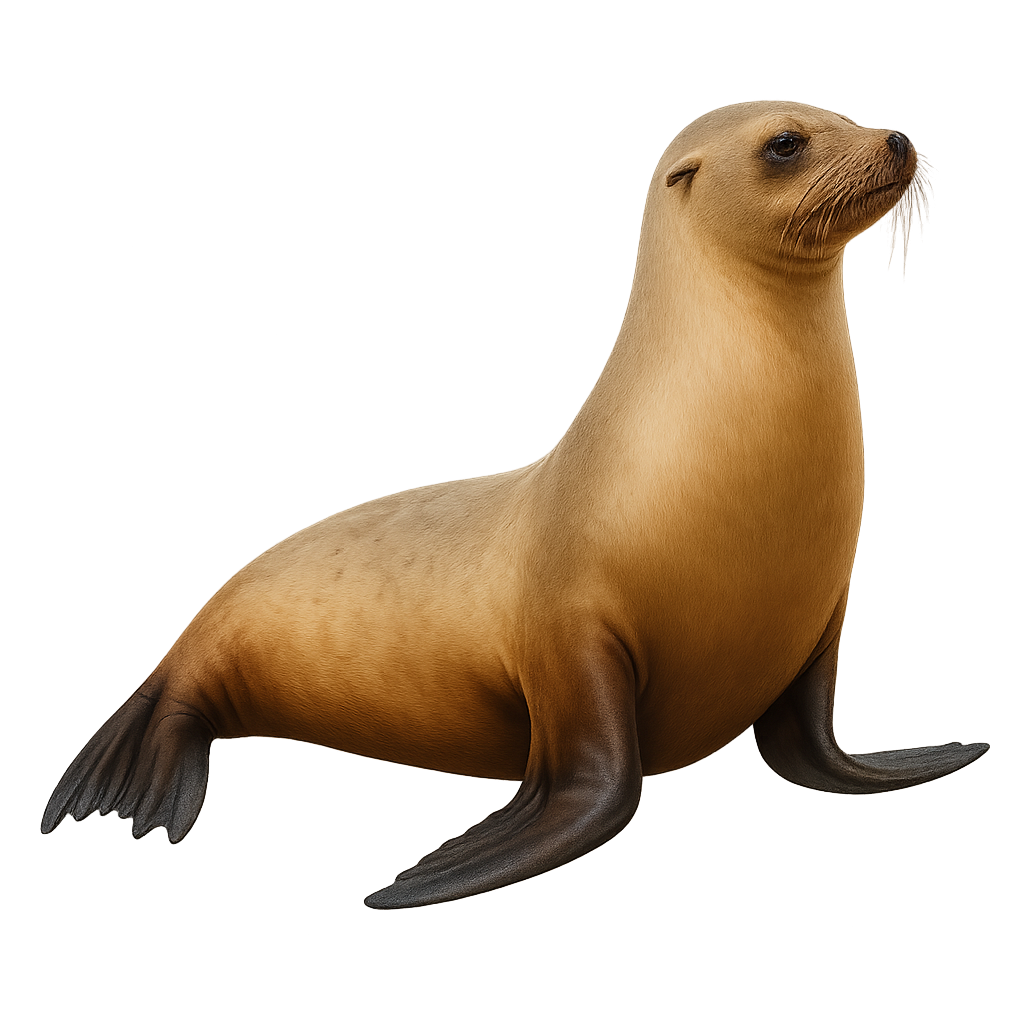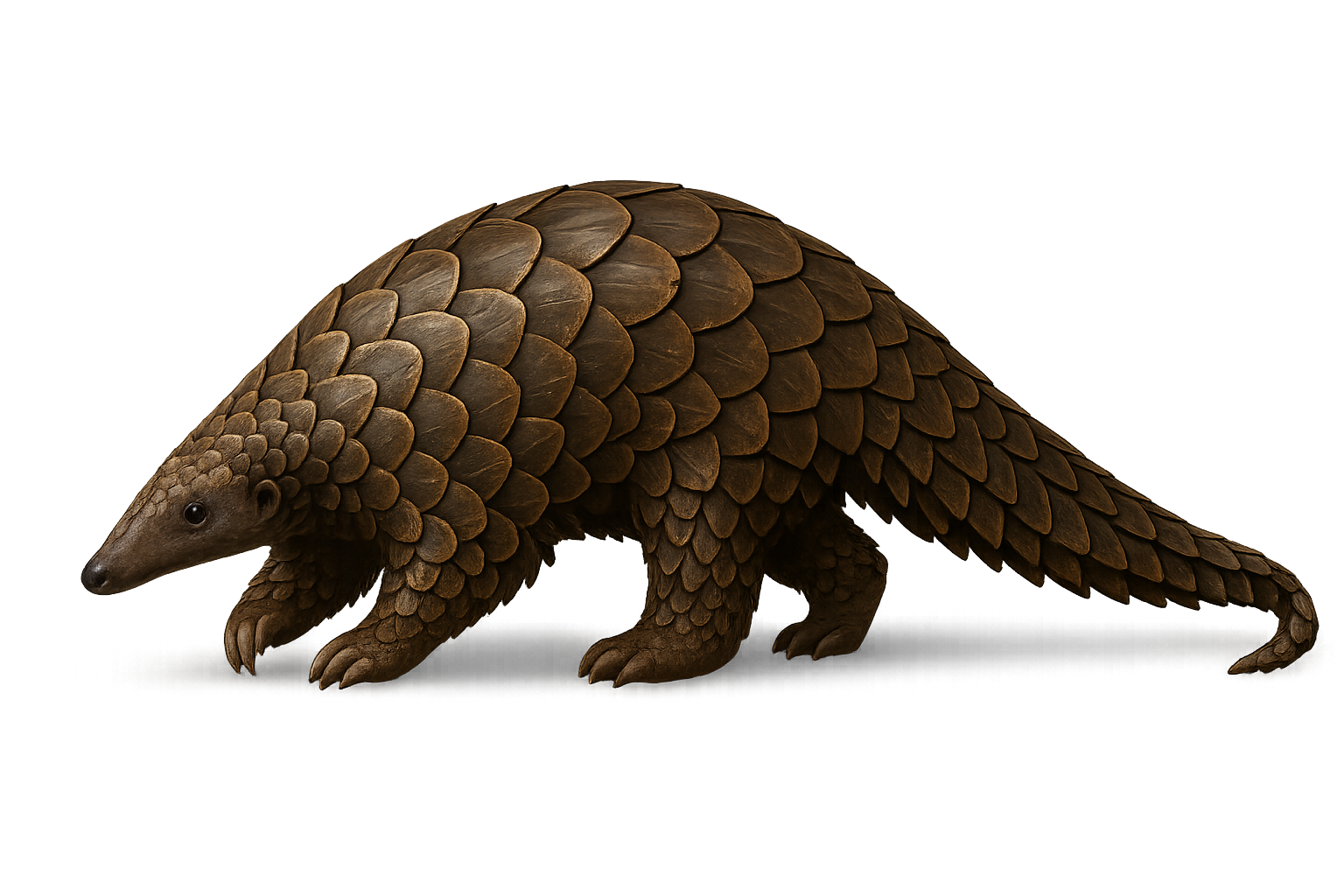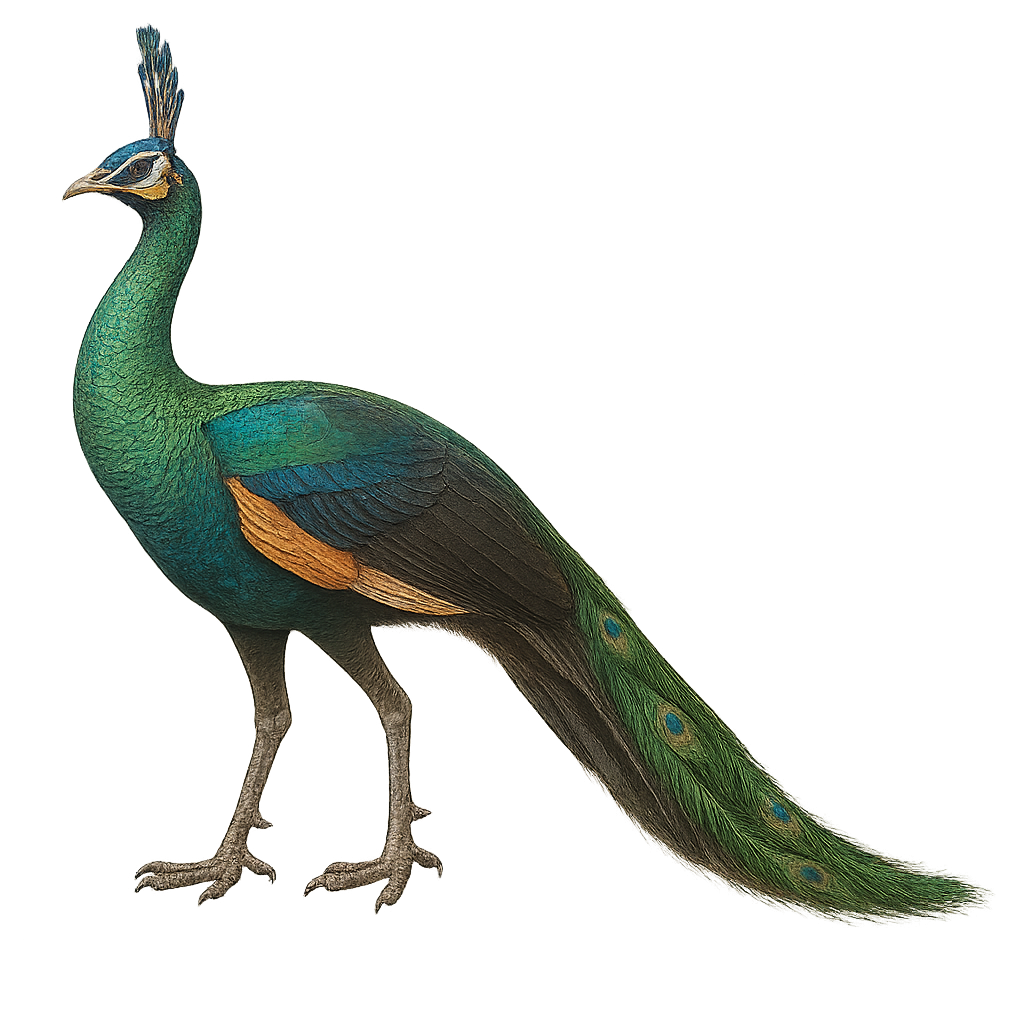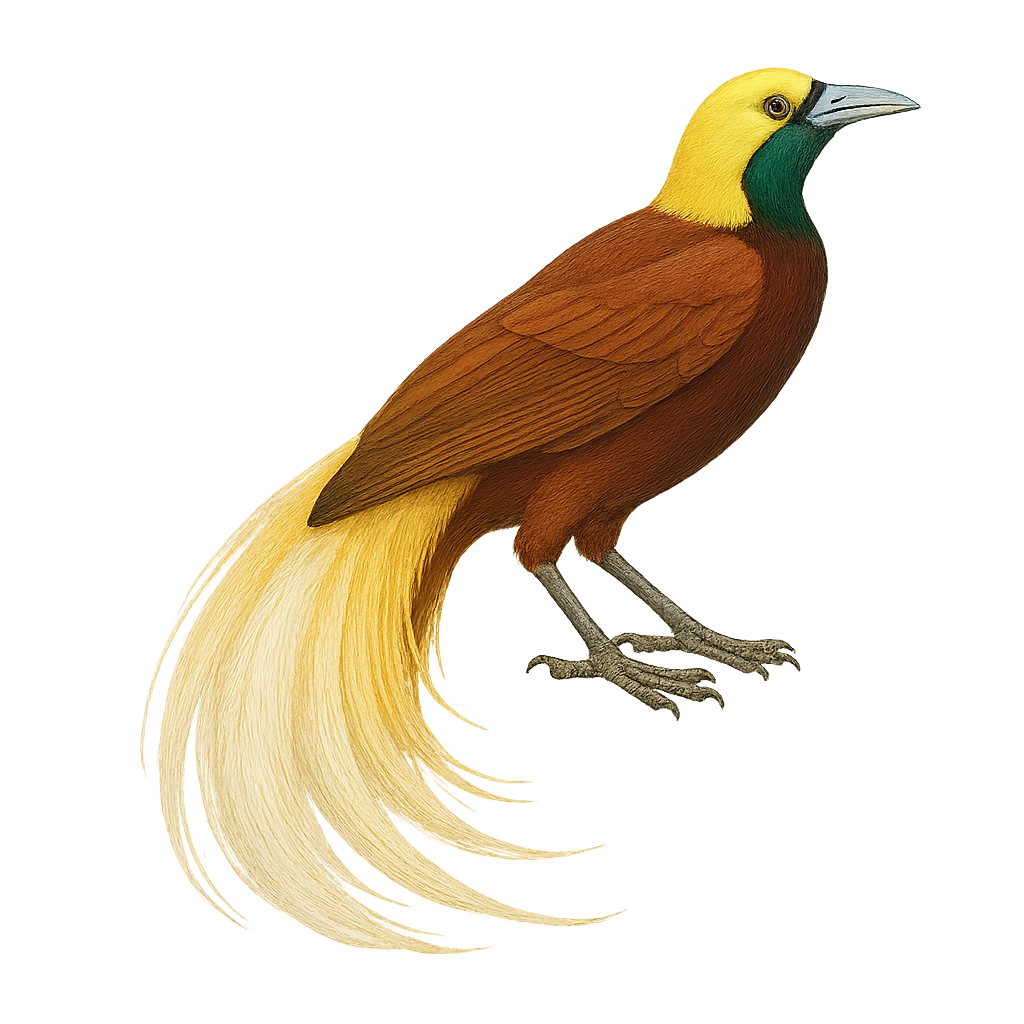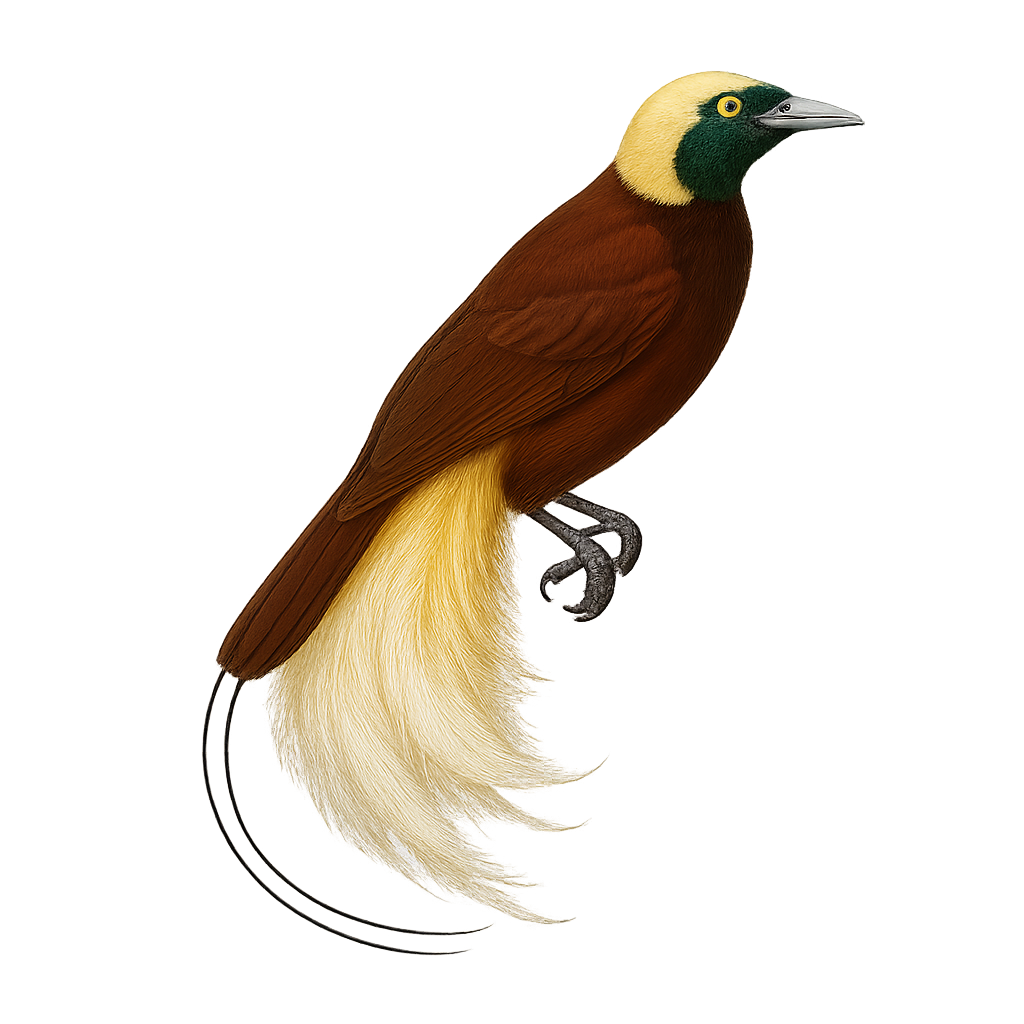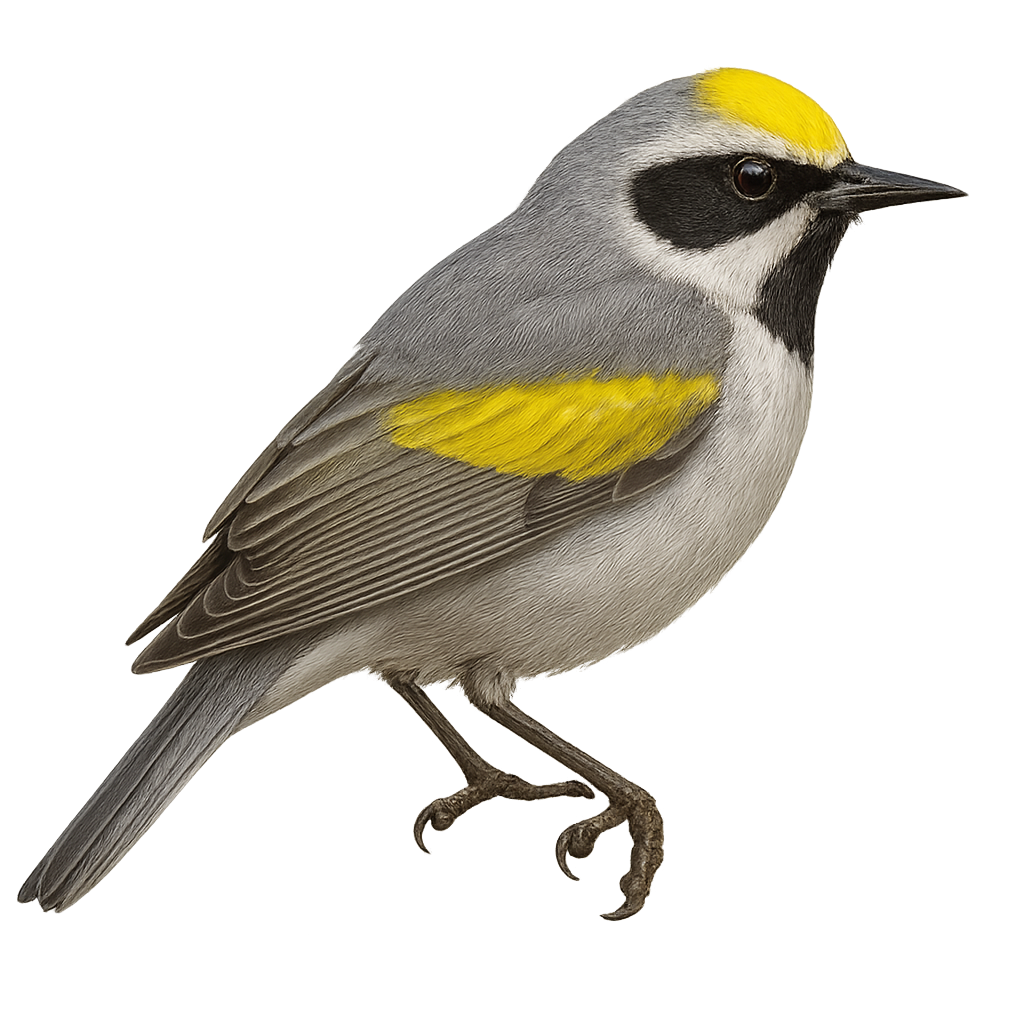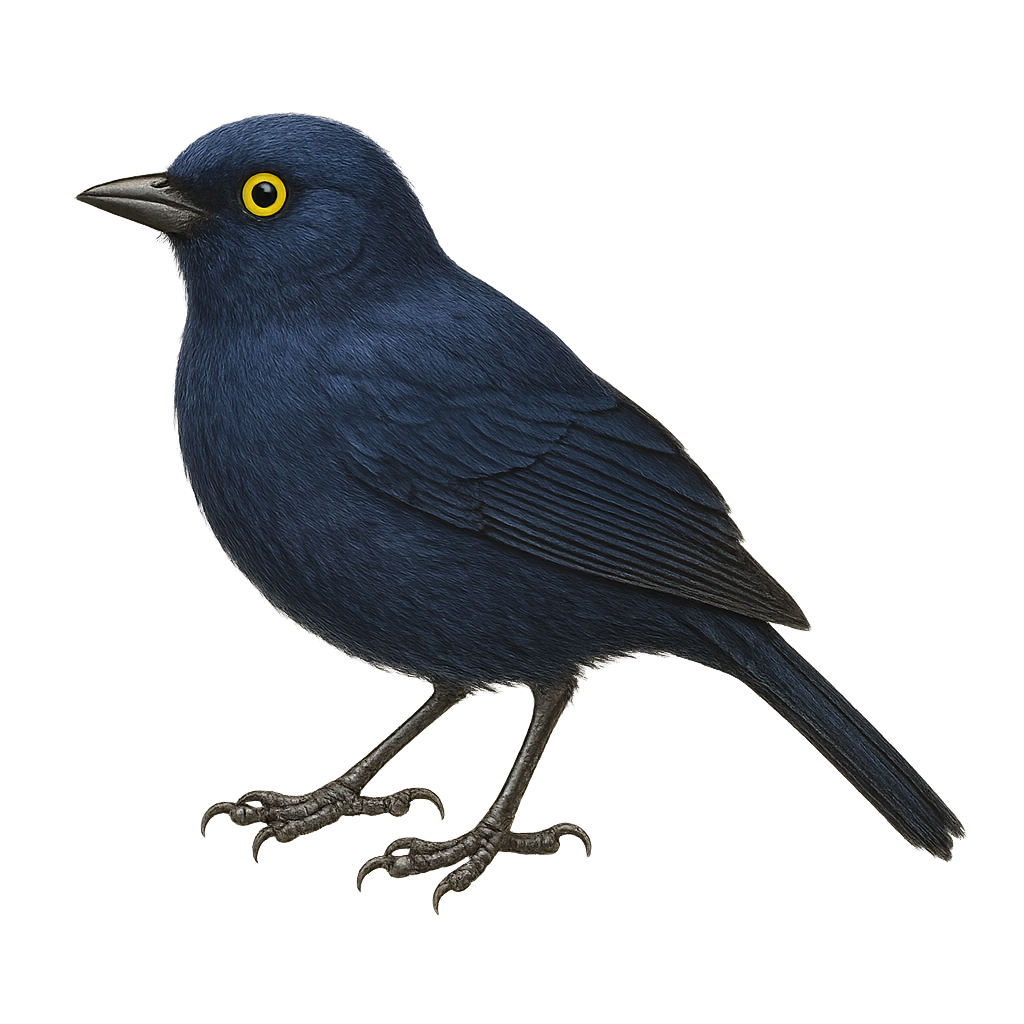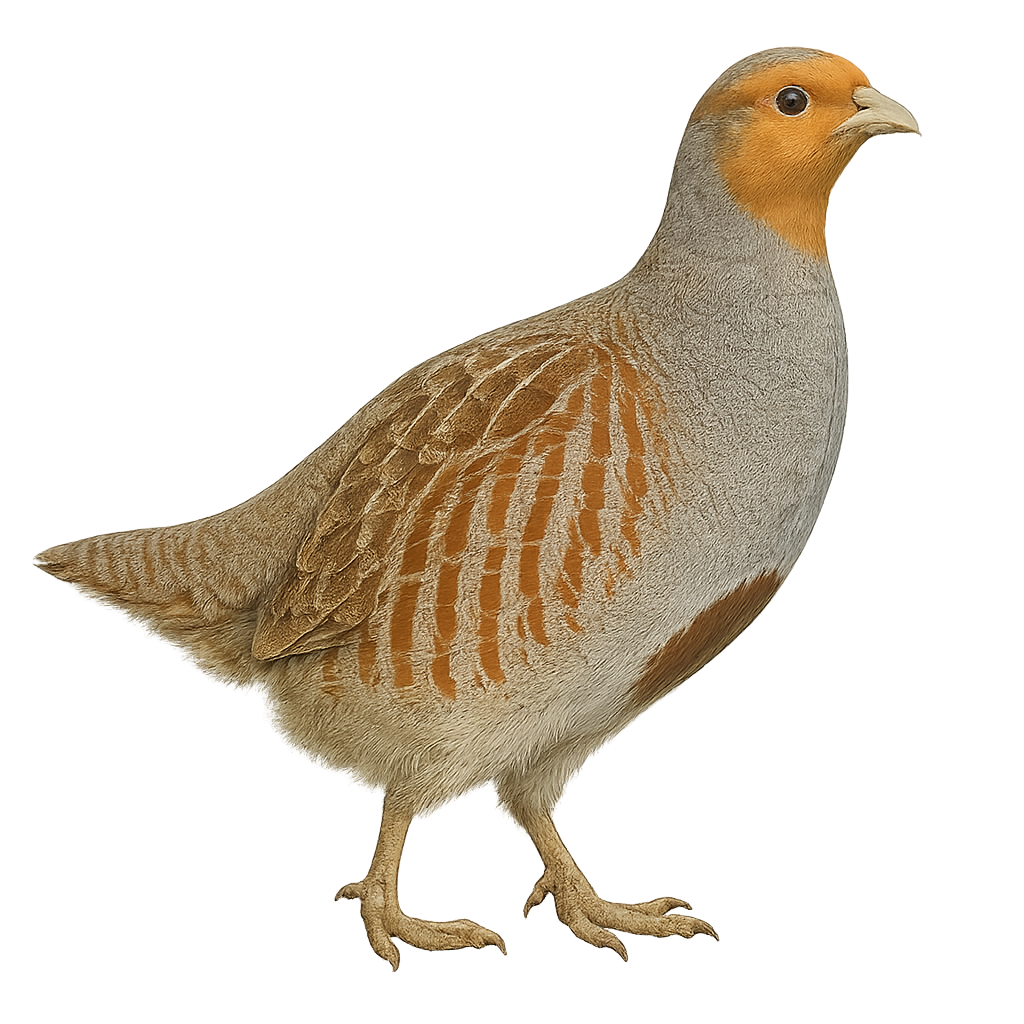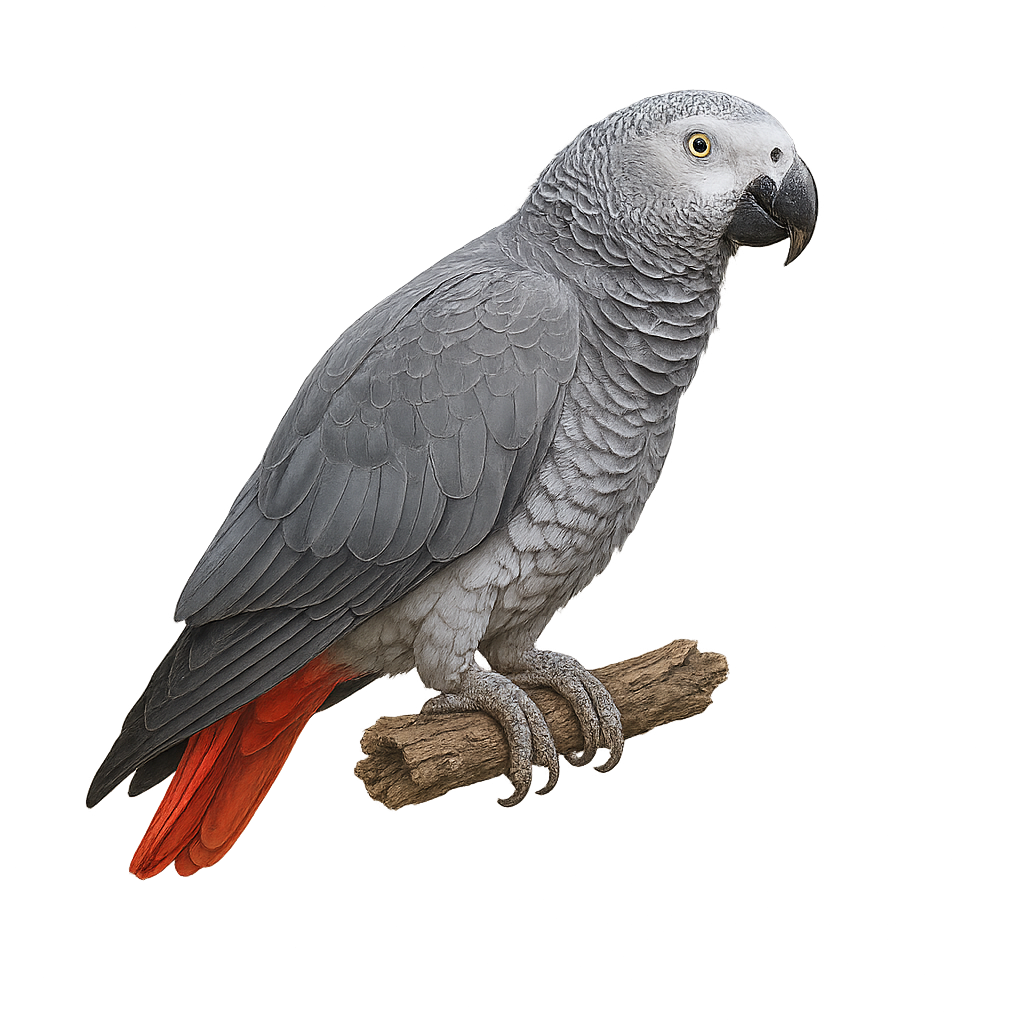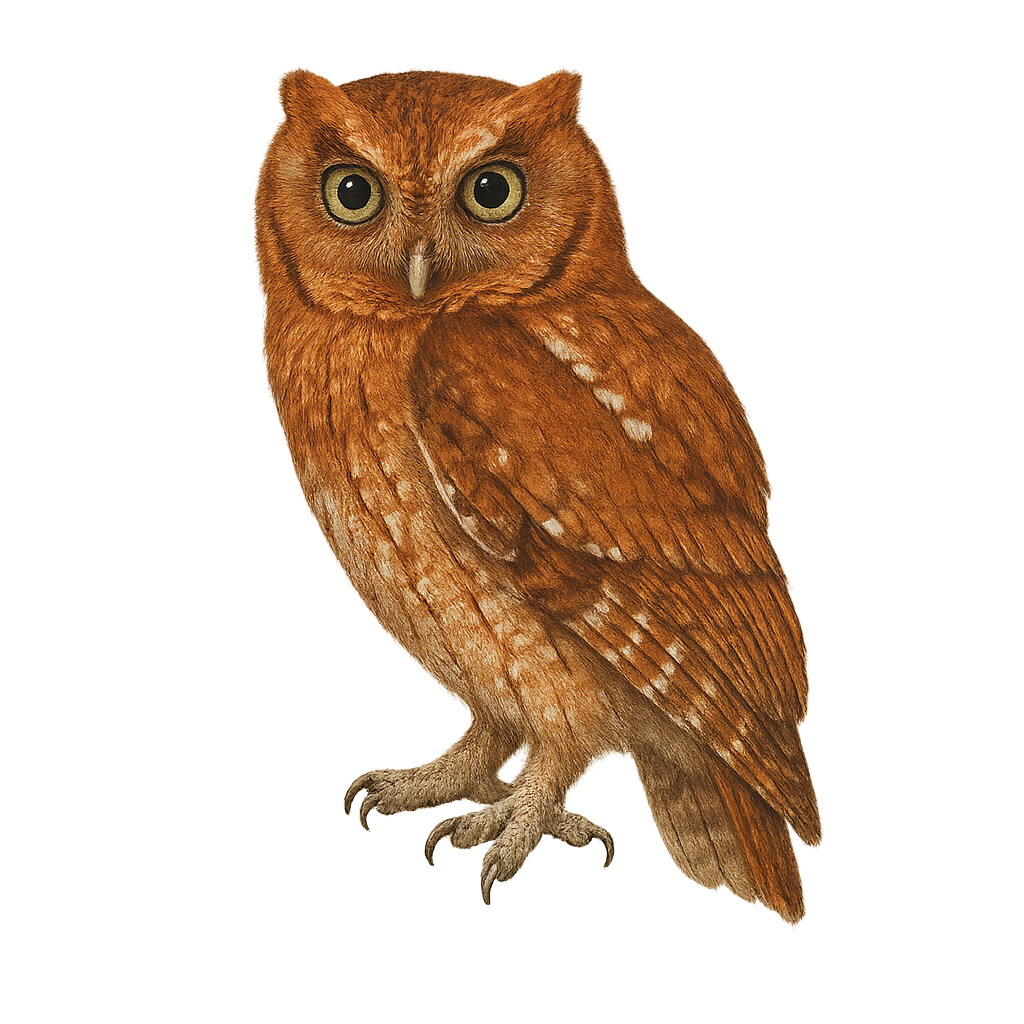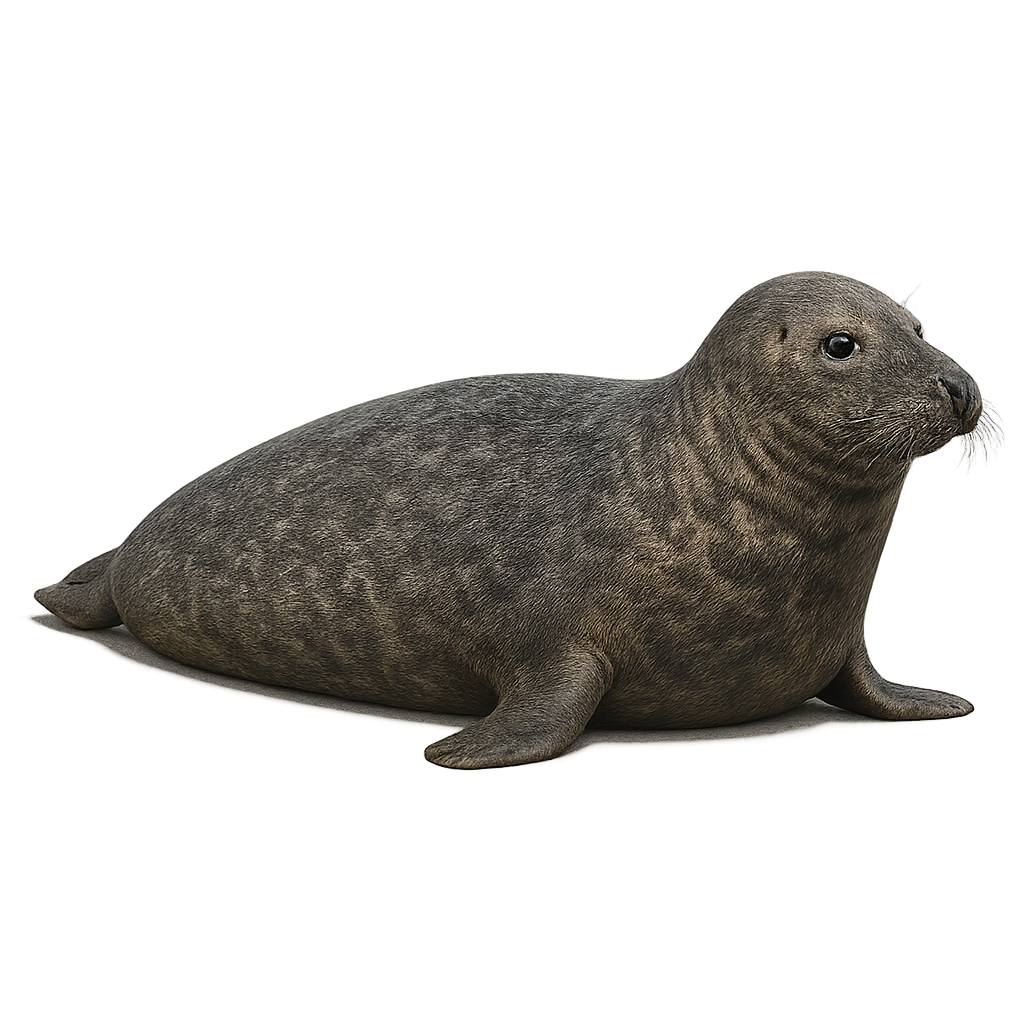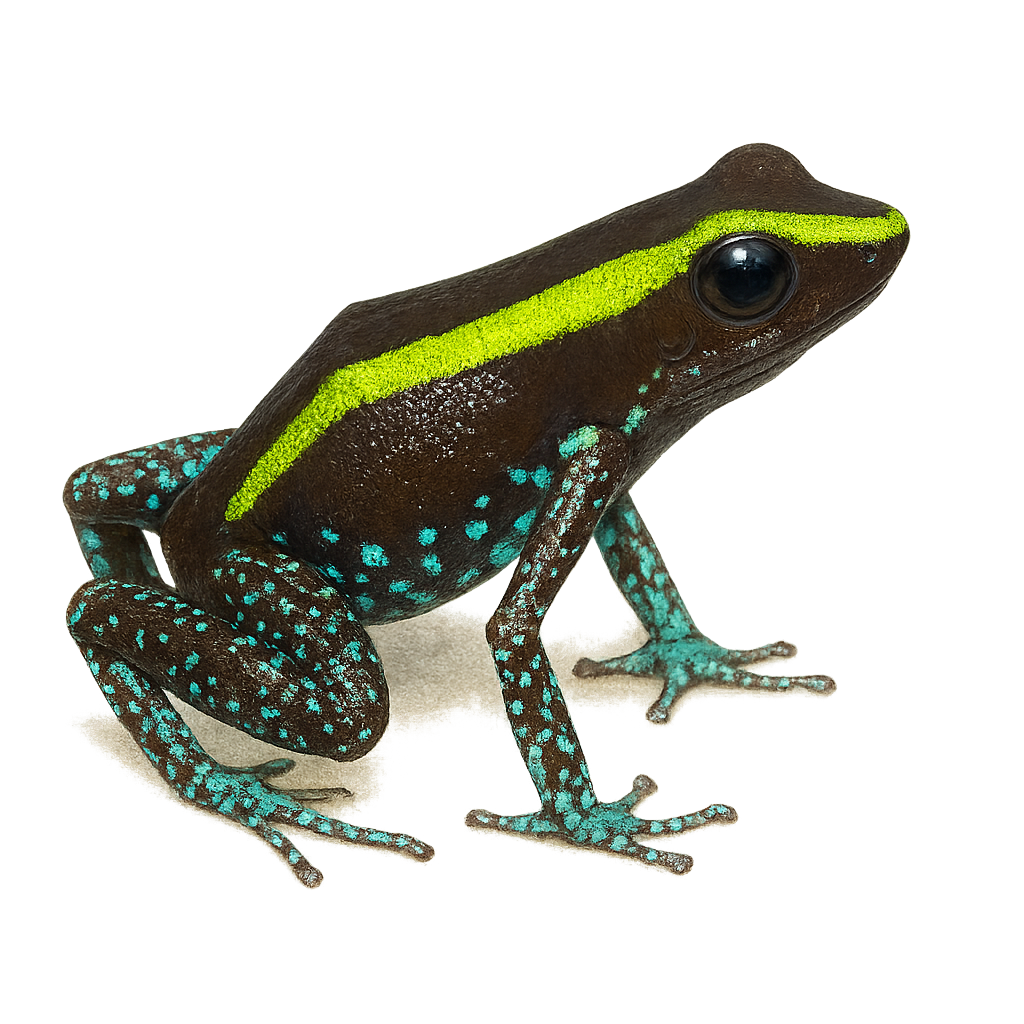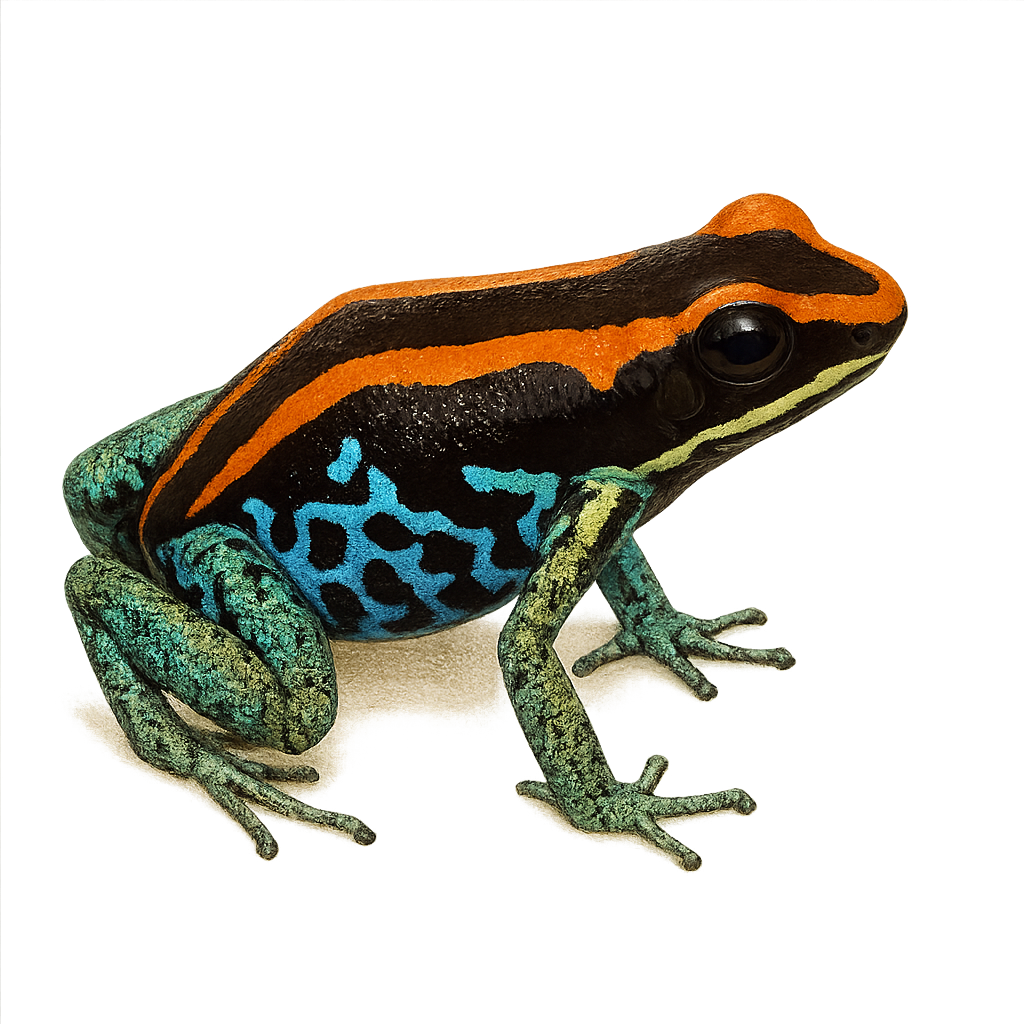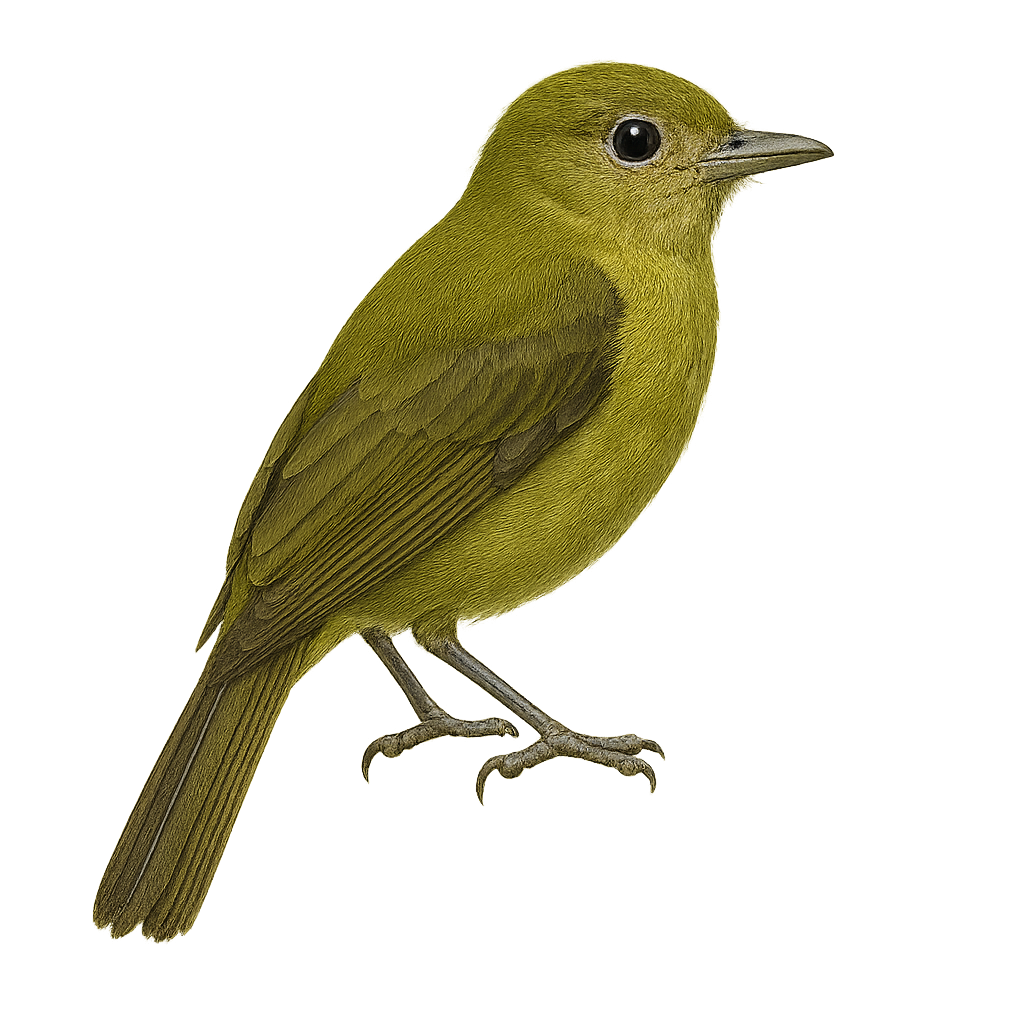The golden mantella is a tiny frog (19–24 mm) with bright orange, toxic skin, living in leaf litter of eastern Madagascar’s rainforests. It feeds on small invertebrates and calls briefly after early wet-season rains to attract mates.
The Greater Adjutant, or Leptoptilos dubius, is a large wading bird from the Ciconiidae family, primarily found in South and Southeast Asia, especially in India and Cambodia. This bird is notable for its impressive size, reaching up to 1.5 meters in height, with a wingspan that can exceed 2.5 meters. Its plumage is mainly gray with white highlights, and it has a bare, often reddish head and neck. The Greater Adjutant is a scavenger, feeding mainly on carcasses, but it can also consume fish and small animals. It plays a crucial ecological role by cleaning ecosystems of decomposing organic matter.
The groundhog, also known as a woodchuck, is a medium-sized rodent belonging to the Sciuridae family. It is widely distributed across North America, particularly in grasslands, forests, and agricultural areas. With a stocky body and thick brown-gray fur, it measures about 40 to 65 cm in length, including the tail. Groundhogs are known for their hibernation behavior, spending the winter in deep burrows. They are primarily herbivorous, feeding on various plants, grasses, and occasionally insects. Although often solitary, they can be observed in small family groups. Their sharp alarm call is used to warn others of predators.
The Giant Kingfisher is the largest of the kingfisher species, measuring between 40 and 45 cm in length and weighing between 200 and 300 g. It has a distinctive plumage, with a metallic blue back, a gray head, and a white belly. Its bill is particularly long and powerful, suited for capturing large aquatic prey, such as fish, reptiles, and even crustaceans. This kingfisher primarily inhabits the banks of rivers and lakes in sub-Saharan Africa, India, Sri Lanka, and southern China, where it often hunts from branches or rocks above the water. Although it is primarily solitary in its hunting activities, it can sometimes be seen in pairs or families during the breeding season. The Giant Kingfisher is an excellent diver but is also known for its ability to catch prey while flying over the water and striking with its bill at great speed. While the species is widely distributed, it faces threats related to habitat loss and water pollution.
The Green Kingfisher is a small, vibrant aquatic bird, measuring about 25 cm in length and weighing between 50 and 100 g. It is distinguished by its bright green plumage on its back, with a white chest and belly, sometimes tinged with orange. Its bill is long, pointed, and straight, ideal for catching fish and aquatic insects. This kingfisher primarily inhabits North and Central America, especially along rivers, lakes, and marshes. It hunts by diving directly into the water from an elevated perch, such as a tree or electrical wire, to capture its prey. The Green Kingfisher is a territorial bird, often observed alone or in small groups during the breeding season. While it is widely distributed, it faces threats such as water pollution, habitat loss, and human disturbance.
The great tit is a small, very common tit found across Europe and Western Asia. It is easily recognizable by its bright yellow plumage, black head, and white cheeks. This passerine bird is commonly seen in gardens, parks, and forests, where it feeds primarily on insects, seeds, and berries. The great tit is known for its curious nature and its ability to adapt to different habitats. It is also an excellent climber, often seen foraging in trees and shrubs.
The Gray Catbird, Dumetella carolinensis, is a medium-sized songbird known for its slate-gray plumage and distinctive black cap. Often found in dense thickets and hedgerows, it primarily feeds on insects and berries. Its varied and melodious song, often mimicking other birds, is a notable feature. This catbird is a migratory species, wintering in the southern United States and Central America, while breeding in eastern and central North America. It builds its nest in low shrubs, using twigs and grasses. Although generally discreet, it can become territorial during the breeding season, vigorously defending its space against intruders.
The Greater Pewee, or Contopus pertinax, is a medium-sized bird belonging to the Tyrannidae family. It is primarily found in the pine and oak forests of mountainous regions in Central America and northern Mexico. Its plumage is generally gray-brown with a lighter chest, and it is distinguished by its slightly raised crest. This pewee is often seen perched on exposed branches, from where it launches to catch flying insects. Its song is a clear, melodious whistle, often heard at dawn. Although primarily insectivorous, it may occasionally feed on small fruits. It is a solitary bird but can be observed in small groups during migration.
The Grey-headed Gull, Chroicocephalus cirrocephalus, is an elegant and distinctive bird, recognizable by its pale grey head contrasting with its white body and light grey wings. It primarily inhabits coastal areas, estuaries, and inland lakes in Africa and South America. During the breeding season, it forms noisy colonies, often in association with other gull and tern species. Its diet is varied, including fish, insects, and human waste. This species is known for its graceful flight and characteristic high-pitched calls. Although its conservation status is currently "least concern," it remains sensitive to human disturbances and habitat degradation.
The greylag goose (Anser anser) is a large migratory waterfowl (75–90 cm in length, 130–160 cm wingspan), distinguished by its smoky-grey plumage, orange bill and pink legs. Found across freshwater wetlands, floodplain meadows and lakes of Europe and Asia, it feeds on grasses, aquatic seeds and mollusks. Highly social, it forms large flocks during migration and wintering. Breeding begins in late February when monogamous pairs perform head-bobbing displays and honking calls. The female lays 5–7 eggs in a ground nest lined with vegetation near water, which incubate for 26–28 days. Precocial goslings leave the nest soon after hatching, grazing and seeking cover alongside parents. In flight, geese famously adopt V formations to conserve energy on long-distance migrations.
The Greater White-fronted Goose, Anser albifrons, is a migratory bird species belonging to the Anatidae family. It is easily recognizable by its brown-gray plumage, white face, and pink bill. Adults have a distinctive white band on the forehead, which gives them their name. This species primarily inhabits wetlands, marshes, and flooded meadows. It migrates over long distances, spending summers in Arctic regions and winters in temperate zones. The Greater White-fronted Goose is social and often gathers in large flocks. It feeds mainly on aquatic plants, seeds, and roots. Although its conservation status is currently of least concern, it is sensitive to environmental changes and habitat loss.
The Golden-rumped Euphonia, or Chlorophonia cyanocephala, is a small, colorful bird belonging to the Fringillidae family. It is characterized by its bright blue head, olive-green back, and vibrant yellow belly. Males have a distinctive golden patch on the rump, which gives them their English name. Females are duller in color, predominantly olive-green. This bird measures about 11 cm in length and weighs between 10 and 14 grams. It is primarily found in the tropical rainforests and wooded areas of Central and South America, where it feeds on fruits, berries, and insects. Its melodious and varied song is often heard in the canopy.
The Golden-rumped Euphonia, or Euphonia mesochrysa, is a small, colorful bird found primarily in the humid forests and wooded areas of South America, notably in Colombia, Ecuador, and Peru. This bird is recognizable by its vibrant plumage, with a golden-yellow belly contrasting with a dark blue back. Males and females exhibit differences in coloration, with females generally being duller. They primarily feed on fruits but can also consume insects. Their song is melodious and complex, often heard at dawn. These birds are social and can be observed in small groups. Although they are quite widespread, their habitat is threatened by deforestation.
The Oryx gazelle is a large, sturdy antelope native to the arid regions of Southern Africa. It stands between 1.2 and 1.5 meters at the withers and weighs between 200 and 250 kg. Its coat is primarily gray or beige, with white markings on the belly, legs, and face, giving it a distinctive appearance. It has long, straight horns, which can reach up to 1 meter in length, and are characteristic of the species. The Oryx gazelle inhabits savannas, steppes, and deserts, where it feeds primarily on herbaceous plants, roots, and fruits. It is well adapted to extreme heat and drought conditions, thanks to its ability to reduce its body temperature and feed on sparse vegetation. While the Oryx gazelle is capable of surviving in desert environments, it is also able to travel long distances in search of food and water. The species is not currently endangered, but it faces threats related to habitat loss and hunting.
The Galápagos Sea Lion, Zalophus wollebaeki, is an iconic species of the Galápagos Islands. These sea lions are recognizable by their dark brown fur and relatively small size compared to other sea lion species. They primarily inhabit the beaches and rocky shores of the islands, where they rest and breed. Galápagos sea lions are highly social and often form large groups. They are also known for their curiosity towards humans, making them a popular attraction for tourists. However, they are vulnerable to human disturbances and environmental changes, leading to their classification as a near-threatened species by the IUCN.
The Giant Panda is a large mammal native to the mountains of China, primarily found in the regions of Sichuan, Shaanxi, and Gansu. It measures between 1.2 and 1.8 meters in length and weighs between 70 and 160 kg. What distinguishes it is its black and white coat, with black patches around its eyes, ears, and paws. The Giant Panda is a strict herbivore, feeding almost exclusively on bamboo, although it may occasionally eat fruits, roots, and small animals. It lives in bamboo forests, where it spends most of its day feeding due to the low nutritional value of its diet. The Giant Panda is a symbol of conservation due to its rarity, and although it is still considered vulnerable, conservation efforts have helped stabilize its population.
The Temminck's Pangolin is a small insectivorous mammal found primarily in Sub-Saharan Africa, notably in South Africa, Botswana, Namibia, and Zimbabwe. It measures about 50 to 60 cm in length, with a tail that makes up a significant portion of its size, and weighs between 3 and 7 kg. This pangolin is covered with large scales made of keratin, which protect it from predators. When threatened, it curls into a ball with its scales rolled outward. It primarily feeds on termites and other insects, which it captures with its long, sticky tongue. Although the Temminck's Pangolin is an excellent burrower, it is unfortunately threatened by poaching for its scales and by habitat loss.
The Giant Pangolin is the largest of the pangolin species, measuring between 1.2 and 1.5 meters in length, with a tail that can account for up to half of its total length. It weighs between 30 and 40 kg. This mammal, covered in large keratin scales, primarily lives in the forests of Central Africa, particularly in the Democratic Republic of the Congo and the Republic of the Congo. It is an excellent burrower and primarily feeds on termites and other insects, which it captures with its long tongue. The Giant Pangolin is a nocturnal and solitary species, using its powerful claws to dig burrows or open insect nests. Although its population is not well-known, the Giant Pangolin is threatened by deforestation, illegal hunting, and poaching for its scales, making it a vulnerable species.
The Green Peafowl, or Pavo muticus, is a magnificent bird native to Southeast Asia. It is known for its striking plumage, primarily iridescent green, and its long train adorned with eye-like patterns. Males have a crest of feathers on their heads and display their spectacular tails during courtship rituals. Females are more subdued in brown-green colors. The Green Peafowl inhabits tropical forests, savannas, and wetlands, feeding on seeds, insects, and small animals. Threatened by habitat loss and hunting, it is listed as vulnerable by the IUCN.
The Goldie's Bird-of-paradise, or Paradisaea decora, is a bird species from the Paradisaeidae family, endemic to Fergusson and Normanby islands in Papua New Guinea. This magnificent bird is renowned for its dazzling plumage and spectacular courtship displays. Males boast golden-yellow and emerald-green feathers, with ornamental plumes that unfurl during their courtship dances. Females, more subdued, have olive-brown plumage. The Goldie's Bird-of-paradise primarily inhabits tropical rainforests, feeding on fruits, insects, and small animals. Unfortunately, this species is threatened by deforestation and hunting, leading to its classification as vulnerable by the IUCN.
The Greater Bird-of-paradise, or Paradisaea apoda, is an iconic bird of the tropical forests of New Guinea. Known for its spectacular plumage, the male displays yellow and brown feathers with green and blue hues on the head. These birds are famous for their complex courtship displays, where males showcase their feathers to attract females. They primarily inhabit the forest canopy, feeding on fruits and insects. Their melodious song and social behavior make them fascinating creatures to observe. Although their habitat is threatened by deforestation, they remain relatively common in some areas.
The Golden-winged Warbler is a small songbird from the Parulidae family, known for its distinctive patterns and colorful plumage. Males display a golden crown and bright yellow wing patches, contrasting with their black and white face. Females, though less vibrant, have similar but subtler markings. These birds primarily inhabit open forests and shrublands in eastern North America. They are insectivorous, feeding mainly on caterpillars and other small invertebrates. The Golden-winged Warbler is a migratory species, spending its winters in Central and South America. Unfortunately, it is threatened by habitat loss and hybridization with the Blue-winged Warbler.
The Glaucous Flowerpiercer is a small passerine bird belonging to the Thraupidae family. It is primarily found in the humid forests of the Andes, where it feeds on nectar and insects. Its most distinctive feature is its bright blue throat, contrasting with its grayish plumage. It uses its slender, slightly curved beak to pierce flowers and access nectar, playing an important role in pollination. This bird is often seen in small groups or pairs, actively moving through the canopy. Although not considered threatened, deforestation poses a potential threat to its natural habitat.
The Grey Partridge is a plump galliform bird, measuring 28–32 cm in length with a wingspan of about 45 cm. It is identified by its mottled brown-grey plumage and a distinctive dark horseshoe-shaped patch on the belly. Males and females are very similar, though the belly patch is usually more defined in males. Found in open farmland, grasslands, fallows, and cultivated fields across Europe and temperate Asia. It is ground-dwelling and sedentary, preferring to run rather than fly when disturbed. Its diet includes seeds, leaves, shoots, and insects, which are vital for chicks. The species is in decline in some areas due to agricultural intensification, habitat loss, and pesticide use.
The Gabon grey parrot is an iconic species known for its exceptional intelligence and ability to mimic human sounds. Native to the tropical forests of Central Africa, primarily from Gabon and the Republic of Congo, this parrot has a grey plumage and a distinctive red head. It is a social bird that primarily feeds on fruits, seeds, and nuts. Unfortunately, the species is threatened by deforestation and illegal wildlife trade.
The Giles's Screech Owl, scientifically known as Megascops gilesi, is a nocturnal bird of prey belonging to the Strigidae family. This small owl is notable for its cryptic plumage, which allows it to blend seamlessly into its wooded surroundings. Its modest size and subtle ear tufts make it a challenging bird to spot. Primarily active at night, it preys on small mammals, insects, and other invertebrates. Its call, a soft and repetitive trill, often echoes through the forests it inhabits. Endemic to certain regions of South America, it resides in subtropical and temperate forests. Although not extensively studied, it is considered a relatively stable species, though deforestation could threaten its habitat in the long term.
The Gray Seal, also known as the Horsehead Seal, is a species of seal found in the coastal waters of the North Atlantic, particularly in Europe and North America. It measures between 2 and 3 meters in length and weighs between 170 and 300 kg. Its fur is typically silver-gray with black spots, and its head is characterized by a wide and elongated snout. The Gray Seal primarily feeds on fish, but also on crustaceans and cephalopods. It spends a lot of time on beaches and rocks for resting and breeding. Although it is not currently threatened, it can be affected by marine pollution, ship collisions, and human disturbance.
Phyllobates aurotaenia, commonly known as the Golden-striped poison frog, is an extremely toxic frog species belonging to the Dendrobatidae family. Native to the humid tropical forests of Colombia, this frog is characterized by its smooth, shiny skin, often black with yellow or green stripes. It secretes a potent toxin through its skin, used by local populations to poison arrows. Measuring about 3 to 4 cm, this species is diurnal and primarily feeds on small insects. Due to deforestation and habitat loss, it is considered vulnerable by the IUCN.
The Golfodulcean Poison Frog, or Phyllobates vittatus, is a tropical frog species known for its toxic skin. Native to the humid forests of Costa Rica, this frog displays striking black and orange stripes, a natural warning of its toxicity. It secretes a potent alkaloid toxin, batrachotoxin, which protects it from predators. Measuring about 3 to 4 cm, it primarily feeds on small insects. The Golfodulcean Poison Frog plays a crucial role in its ecosystem by regulating insect populations. Although its toxicity is formidable, it is harmless to humans if not handled. This species is currently threatened by deforestation and the loss of its natural habitat.
The Grey-tailed Piha, or Snowornis cryptolophus, is a fascinating bird found in the humid forests of South America. It is characterized by its subtle plumage, mainly grey with hints of brown and green, allowing it to blend seamlessly into its surroundings. This bird is often challenging to spot due to its discreet behavior and dense habitat. It primarily feeds on fruits but may also consume insects. The Grey-tailed Piha is a solitary bird, although it can sometimes be seen in small groups during the breeding season. Its song is melodious yet discreet, adding to the difficulty of locating it in the wild.


